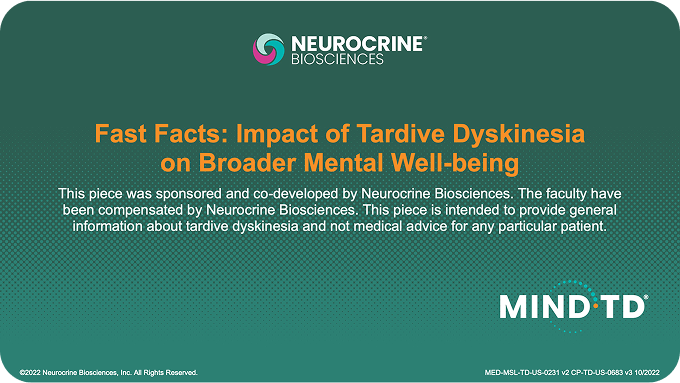This is a hypothetical patient case developed for educational purposes by Leslie Citrome, MD, MPH, based on characteristics of patients with tardive dyskinesia as seen in clinical practice. The hypothetical case was sponsored and co-developed by Neurocrine Biosciences.
Paul B. is a 55-year-old man with chronic schizophrenia living in an adult home. He presented to his treating clinician after a caregiver noticed his hands seemed to be moving “all the time” and “flicking.”
He was also spilling food during meals. Others have told him to stop chewing gum at church services, even though there was no gum in his mouth. He has gotten upset when told he is grimacing.
Patient Information
- Name: Paul B.
- Age: 55 y
- Sex: Male
- Race/Ethnicity: White
- BMI: 26
- BP: 160/100 mm Hg
- Current problems:
- Schizophrenia
- Hypertension
- Current medications:
- Aripiprazole lauroxil 882 mg q4wk
- Benztropine 2 mg BID
- Amlodipine 5 mg daily
BID, twice daily; BMI, body mass index; BP, blood pressure; q4wk, every 4 weeks.
Paul was diagnosed with schizophrenia in his 20s and has been treated with first- and second-generation antipsychotics on and off for 30 years. Hallucinations and delusions have remained under good control with the use of long-acting injectable antipsychotics. Based on his history, the goals of the case are to maintain control of his psychiatric symptoms and evaluate the cause of his abnormal movements.
Psychiatric History
- Current diagnosis: Schizophrenia
- Previous psychiatric diagnoses: None reported
- Current psychiatric medication: Aripiprazole lauroxil 882 mg q4wk
- Psychiatric medication history: Haloperidol decanoate 150 mg IM off and on for ~28 years
- Safety concerns: None reported
- Previous psychiatric hospitalizations: >10 years ago
- Substance use: None reported
IM, intramuscular.
Years ago, Paul experienced acute tremor and rigidity during a psychiatric hospitalization after starting high-dose haloperidol for psychotic symptoms. When he was switched from haloperidol to aripiprazole 2 years ago, his physician added benztropine as prophylaxis for drug-induced parkinsonism. He has been taking it for the past 2 years.
History of Movement Disorders
- History of rhythmic tremor and rigidity during psychiatric hospitalization and treatment with high-dose first-generation antipsychotics
- Acute dystonic reaction to haloperidol
- Prescribed benztropine 2 mg BID when switched from haloperidol to aripiprazole 2 years ago as prophylaxis for drug-induced parkinsonism
Paul’s treating clinician recalled that anticholinergics can make certain movement disorders, such as tardive dyskinesia, worse and not better,1 and an effort was made to decrease the dose of benztropine gradually over several weeks. A motor evaluation revealed that the hand movements had improved somewhat but did not fully resolve. Mouth movements were still notable. There was no rigidity and gait was normal with normal arm swing.2 There was no evidence of parkinsonian tremor. AIMS examination revealed a total dyskinesia score of 8 and a global assessment rating of 3.3 A diagnosis of TD was made, with moderate severity.
Motor Evaluation
- Abnormal facial and oral movements
- Choreic movement of hands and fingers
- No muscle rigidity noted
- Normal gait with normal arm swing
- No tremor observed
- AIMS exam:
- Total dyskinesia score: 8
- Global assessment rating: 3
AIMS, Abnormal Involuntary Movement Scale.
Paul’s treating clinician provided him with education about TD and the available treatments. They made the decision together with his caregiver to begin treatment of his TD with a VMAT2 inhibitor.
Notes From Today's Visit
- Provided education about TD
- Initiated treatment with a VMAT2 inhibitor
- Follow-up in 1 month
References
- Benztropine mesylate [package insert]. Lake Forest, IL: Akorn; 2017.
- Fahn S, et al, eds. Principles and Practice of Movement Disorders. 2nd ed. Saunders; 2011:415-446.
- Rush JA. Handbook of Psychiatric Measures. 2000:166-168.








